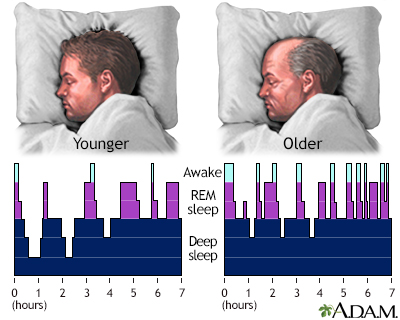Sleep disorders
 Print-Friendly
Print-Friendly
Insomnia; Narcolepsy; Hypersomnia; Daytime sleepiness; Sleep rhythm; Sleep disruptive behaviors; Jet lag
Sleep disorders are problems with sleeping. These include trouble falling or staying asleep, falling asleep at the wrong times, too much sleep, and abnormal behaviors during sleep.
I Would Like to Learn About:
Causes
There are more than 100 different sleeping and waking disorders. They can be grouped into four main categories:
- Problems falling or staying asleep (insomnia)
- Problems staying awake (excessive daytime sleepiness)
- Problems sticking to a regular sleep schedule (sleep rhythm problem)
- Unusual behaviors during sleep (sleep-disruptive behaviors)
PROBLEMS FALLING AND STAYING ASLEEP
Insomnia includes trouble falling asleep or staying asleep. Episodes may come and go, last up to 3 weeks (be short-term), or be long-lasting (chronic).
PROBLEMS STAYING AWAKE
Hypersomnia is a condition in which people have excessive daytime sleepiness. This means they feel tired during the day and are prone to falling asleep. Hypersomnia can also include situations in which a person needs to sleep a lot. This may be due to other medical conditions, but can also be due to a problem in the brain. Causes of this problem include:
- Medical conditions, such as fibromyalgia and low thyroid function
- Medicines that are sedating
- Mononucleosis or other viral illnesses
- Narcolepsy and other sleep disorders
- Obesity, especially if it causes obstructive sleep apnea
When no cause for the sleepiness can be found, it is called idiopathic hypersomnia.
PROBLEMS STICKING TO A REGULAR SLEEP SCHEDULE
Problems may also occur when you do not stick to a regular sleep and wake schedule. This occurs when people travel between time zones. It can also occur with shift workers who are on changing schedules, especially nighttime workers.
Disorders that involve a disrupted sleep schedule include:
- Irregular sleep-wake syndrome
- Jet lag syndrome
- Shift work sleep disorder
- Delayed sleep phase, as in teenagers who go to sleep very late at night and then sleep until noon
- Advanced sleep phase, as in older adults who go to sleep early in the evening and wake up very early
SLEEP-DISRUPTIVE BEHAVIORS
Abnormal behaviors during sleep are called parasomnias. They are fairly common in children and include:
- Sleep terrors
- Sleepwalking
- REM sleep-behavior disorder (a person moves during REM sleep and may act out dreams)
Related Information
References
Avidan AY. Sleep and its disorders. In: Jankovic J, Mazziotta JC, Pomeroy SL, Newman NJ, eds. Bradley and Daroff's Neurology in Clinical Practice. 8th ed. Philadelphia, PA: Elsevier; 2022:chap 101.
Sateia MJ, Thorpy MJ. Classification of sleep disorders. In: Kryger M, Roth T, Goldstein CA, Dement WC, eds. Principles and Practice of Sleep Medicine. 7th ed. Philadelphia, PA: Elsevier; 2022:chap 69.









